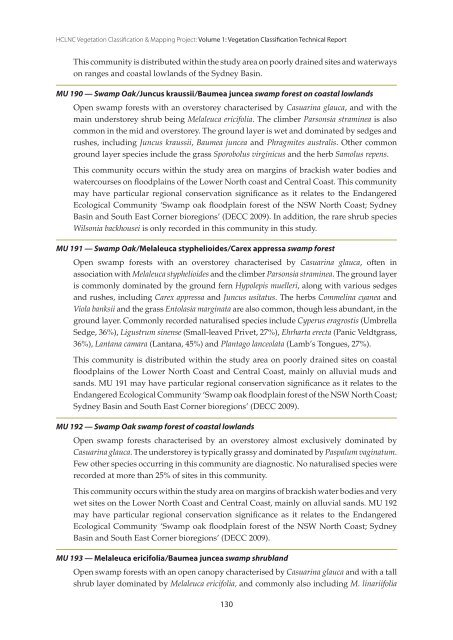Free Download - HCCREMS
Free Download - HCCREMS
Free Download - HCCREMS
You also want an ePaper? Increase the reach of your titles
YUMPU automatically turns print PDFs into web optimized ePapers that Google loves.
HClNC Vegetation Classification & mapping Project: Volume 1: Vegetation Classification Technical Report<br />
This community is distributed within the study area on poorly drained sites and waterways<br />
on ranges and coastal lowlands of the Sydney Basin.<br />
MU 190 — Swamp Oak / Juncus kraussii / Baumea juncea swamp forest on coastal lowlands<br />
Open swamp forests with an overstorey characterised by Casuarina glauca, and with the<br />
main understorey shrub being Melaleuca ericifolia. The climber Parsonsia straminea is also<br />
common in the mid and overstorey. The ground layer is wet and dominated by sedges and<br />
rushes, including Juncus kraussii, Baumea juncea and Phragmites australis. Other common<br />
ground layer species include the grass Sporobolus virginicus and the herb Samolus repens.<br />
This community occurs within the study area on margins of brackish water bodies and<br />
watercourses on floodplains of the Lower North coast and Central Coast. This community<br />
may have particular regional conservation significance as it relates to the Endangered<br />
Ecological Community ‘Swamp oak floodplain forest of the NSW North Coast; Sydney<br />
Basin and South East Corner bioregions’ (DECC 2009). In addition, the rare shrub species<br />
Wilsonia backhousei is only recorded in this community in this study.<br />
MU 191 — Swamp Oak / Melaleuca styphelioides / Carex appressa swamp forest<br />
Open swamp forests with an overstorey characterised by Casuarina glauca, often in<br />
association with Melaleuca styphelioides and the climber Parsonsia straminea. The ground layer<br />
is commonly dominated by the ground fern Hypolepis muelleri, along with various sedges<br />
and rushes, including Carex appressa and Juncus usitatus. The herbs Commelina cyanea and<br />
Viola banksii and the grass Entolasia marginata are also common, though less abundant, in the<br />
ground layer. Commonly recorded naturalised species include Cyperus eragrostis (Umbrella<br />
Sedge, 36%), Ligustrum sinense (Small-leaved Privet, 27%), Ehrharta erecta (Panic Veldtgrass,<br />
36%), Lantana camara (Lantana, 45%) and Plantago lanceolata (Lamb’s Tongues, 27%).<br />
This community is distributed within the study area on poorly drained sites on coastal<br />
floodplains of the Lower North Coast and Central Coast, mainly on alluvial muds and<br />
sands. MU 191 may have particular regional conservation significance as it relates to the<br />
Endangered Ecological Community ‘Swamp oak floodplain forest of the NSW North Coast;<br />
Sydney Basin and South East Corner bioregions’ (DECC 2009).<br />
MU 192 — Swamp Oak swamp forest of coastal lowlands<br />
Open swamp forests characterised by an overstorey almost exclusively dominated by<br />
Casuarina glauca. The understorey is typically grassy and dominated by Paspalum vaginatum.<br />
Few other species occurring in this community are diagnostic. No naturalised species were<br />
recorded at more than 25% of sites in this community.<br />
This community occurs within the study area on margins of brackish water bodies and very<br />
wet sites on the Lower North Coast and Central Coast, mainly on alluvial sands. MU 192<br />
may have particular regional conservation significance as it relates to the Endangered<br />
Ecological Community ‘Swamp oak floodplain forest of the NSW North Coast; Sydney<br />
Basin and South East Corner bioregions’ (DECC 2009).<br />
MU 193 — Melaleuca ericifolia / Baumea juncea swamp shrubland<br />
Open swamp forests with an open canopy characterised by Casuarina glauca and with a tall<br />
shrub layer dominated by Melaleuca ericifolia, and commonly also including M. linariifolia<br />
130


